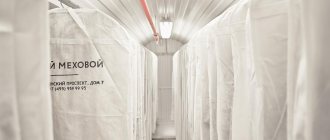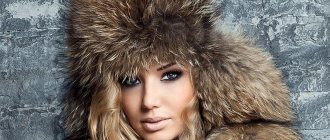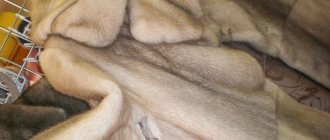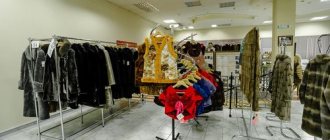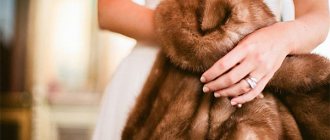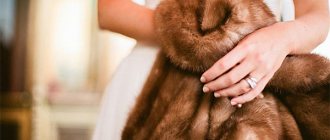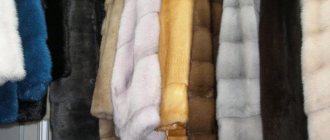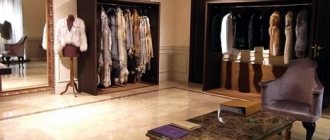It’s not difficult to buy a beautiful fur coat now, so not many people order tailoring of fur products in an atelier or from private craftsmen. If you have a non-standard figure or you live in a small town, then you won’t be able to simply buy a coat. In this case, a fur studio may be the only way out. With its help you will get stylish and beautiful outerwear. Let's figure out how much it costs to sew a fur coat to order, and what it depends on.
How do studios set prices?
Custom tailoring can cost different prices. The master is ready to name it only after he knows what parameters the finished product will have. The following factors can affect the price:
- Type of fur. If the skins are provided by the studio itself, then this factor may become a pricing factor. If you use your own fur, the price of a fur coat will be 50% less. If you sew from a master’s fur, he will pay a certain percentage for its damage.
- The final size of the product and the initial parameters of the skins. If you sew a coat from whole skins or ready-made fabrics, then making it will cost less than making it from scraps. A full-length fur coat will be more expensive than a short one intended for motorists. Wide sleeves can increase the cost of the product.
- Presence of fur defects. This factor will affect the price, even if you bring your own raw materials. The master evaluates the skins according to several parameters: size, color, density and length of the pile, color, softness and strength. The quality of the skin can be affected by the skill of the tanner and the place where the animal is slaughtered. Some defects require special processing when sewing, so the studio charges a premium for this.
- Peculiarities of cutting skins and the product itself. The amount of fur that goes into a fur coat depends on the skill of the cutter. The number of flaps from which it will be assembled is also important. Therefore, this parameter also affects the final cost of the product.
- Cost of sewing work. If you use your own fur, this factor will influence the final price the most. It is worth understanding that there are many ways to join skins, and sometimes even manual labor is required, so the cost of this can be about 30% of the cost of the entire product. If the master is eminent, then it can even exceed the price of fur.
- Availability of patterns. If you choose a fur coat from a master's catalog, it will cost you less. A unique product that requires creating a model from scratch is more expensive.
- The need to combine materials. Not every craftsman will undertake the creation of a fur coat from the skins of different animals, so the cost of the final product may be 30% higher.
If you need additional services (fur combing, hydrophobization, treatment with preparations that create a luxurious shine on the hair), then you will have to pay extra for this by agreement with the masters. The price of such services will depend on the drugs used and the type of work.
Fur studio services
The fur studio "Accessory Fur" occupies a leading position in the repair of fur coats, in the sales of semi-finished fur products and in the production of high-quality hats. In 2016, the company launched tailoring of fur products to order according to an individual sketch. We can also sell mink, sable, and astrakhan fur coats at a fairly reasonable price. Having assembled a team of highly qualified craftsmen, we began to take on individual orders of any level of complexity.
Our specialists are considered one of the best masters in sewing fur products: from rabbit to sable, lynx or chinchilla. High-quality cutting of fur coats is also included in the list of services. Having close ties with the design studio “SAGA FURS”, our company regularly sends its specialists for advanced training, where they continue to improve their work skills. In the process of studying, many creative ideas are born, and modern sewing technologies are also studied.
Do you need a fur coat repaired or would you like to have your fur coat altered inexpensively? Our professional fur studio has access to any sewing technology, including fur inlay (appliqué) and knitting. We bring to life any available ideas in fur production.
Sewing a fur coat to order is not just buying a fur coat, it is much more. Think about it, because you will be the one who can come up with the design of your fur coat and take part in the pattern. You can also make your own changes and wishes. Specialists will help with the selection of fur, as well as competent and high-quality tailoring of an individual product. This way you will receive a unique item that was created just for you.
You can get advice from our studio on repairing fur coats, repairing fur accessories, sewing fur products to order and any other questions you are interested in by calling +7 (958) 811 18 88.
How much does it cost to make a fur coat from different furs?
Most of the studio's clients do not have enough skins to sew fur coats. Therefore, they have to take fur that the master already has. Depending on its type, you can sew a fur coat at different prices. Here are the average prices for how much a finished product can cost, based on the type of fur:
- rabbit – from 20,000 rubles;
- muskrat – from 25,000;
- Karakul – from 35,000;
- beaver, fox – from 30,000;
- mink – from 35,000;
- protein – from 40,000;
- broadtail – from 40,000;
- chinchillas – from 60,000;
- lynx – from 65,000;
- sable – from 70,000.
The price may increase if you need an original product from a renowned artist. It will decrease by about 60% if you offer to use your own fur. But not all masters offer such a discount; in most cases, the final price depends on personal agreements.
Types of fur coats by type of manufacture
Products are divided into natural and artificial .
It is clear that women prefer natural, noble fur, but what is the cost of cruelty to animals? Fur is the skin of an animal, mainly from the family of mustelids, cats, rodents and lagomorphs. Such products are divided into smooth or fluffy. Such fur has long been used for sewing warm outer clothing, which, first of all, protected from cold and frost. It also showed the high status and position of the person who owned the fur item.
The advantages of such fur are obvious:
- provides warmth and comfort in cold weather;
- due to innovative manufacturing methods, products have become more delicate, light and soft, as the technique of cutting and artificial dressing of natural fur began to be used;
- beauty and chic of fur clothing.
Faux fur is made from textiles that closely imitate natural fur.
The composition consists of a primer made of knitwear or artificial leather, onto which a special pile made of chemical or natural textile raw materials is attached. Faux fur is made on weaving machines or knitted on knitting machines; it can also be stitched (tufted, which is made on loop machines with the formation of loops of lint or with an applied unnatural lint).
Which fur coats cost more?
If you order a fur coat entirely from studio materials or simply do not purchase the desired accessories in advance, then the final price may be affected by:
- The quality of the chosen fasteners, laces and other decor. It should be high. If you choose branded fittings, you will have to pay more.
- Auxiliary materials used. Their cost can be very high.
- Availability of decor. Not every craftsman knows how to beautifully combine fur and leather inserts. If the model contains complex combinations or additional decor, the studio or private individual will set a higher price.
In most cases, how much a custom-made fur coat will cost depends only on the price list of a particular master or studio. If you have your own fur, then they may ask for 5 or 50 thousand rubles for the work. If you want the skins to be selected by a master, then the price can change tens of times, depending on the animal from which the coat will be made. The maximum price is charged for a sable product.
How are faux fur coats made?
Faux fur is now popular in most countries.
It is made on specialized weaving looms, machines and karakul laying machines. This fur contains a pile and a base. In order to make a fur coat you need:
- to produce artificial fur, which is equal to two lengths of the future artificial pile, soil containing strong fibers is stirred;
- these fibers are firmly and tightly intertwined with a thin pile cloth, and a multi-layer fabric is obtained between two ground cloths;
- then cut the resulting fabric in half, the pile will be the same length;
- the reverse side is treated with glue.
Each type of faux fur has its own properties and production technology.
How to sew a sheepskin coat with your own hands
DIY sweater hat
Soft trap
In 2020, the fur business was dealt another blow not by environmental activists, but by the coronavirus pandemic: minks, which are the most important asset of the fur market, became carriers of the SARS-CoV-2 virus, which causes COVID-19. The WHO report states that the new Cluster 5 coronavirus variation (which was found in both minks and fur farm employees) is dangerous because it reduces the body’s ability to produce antibodies to the coronavirus, and therefore reduces the effectiveness of future vaccines.
In the Netherlands, a coronavirus outbreak began in the spring on mink farms in Derne. Of the 97 employees tested on 16 farms, 66 people tested positive for Covid (67% of the total). It was assumed that at least two of them became infected from minks, since their SARS-CoV-2 indicators were identical to those found in animals. Fearing a serious outbreak and the possibility that these locations could become a long-term source of infection, the Ministry of Agriculture ordered the destruction of more than 600,000 animals. The government also closed all fur farms until 2021, and ordered farmers to either destroy the mink (if the farm is infested) or use it for fur. There are currently about 150 fur farms in the Netherlands, but from 2024 the farming of mink for fur will be prohibited in the country.
Before this, back in May, a mink farm was temporarily closed for quarantine in the Spanish city of Teruel after seven of its employees were diagnosed with coronavirus. After this, the animals were periodically tested for Covid. In July, Spain's Ministry of Agriculture, Livestock and Environment ordered the destruction of some 100,000 minks due to a coronavirus outbreak at a fur farm in Aragon. The next country where they continued to euthanize minks according to the same scenario was Denmark, which ranks second in terms of mink farming in the world: in November, 284 farms were infected with COVID-19, and another 25 farms were under suspicion. In total, they planned to destroy about 17 million animals, but so far 10 million have been destroyed. As a result, the country proposed to ban mink breeding until December 31, 2022, in order to stop the spread of the virus, and to pay compensation to farms. The situation in Denmark has seriously shaken the future of the entire industry. The world's largest fur auction, Kopenhagen Fur, owned by the Danish Fur Association, said it would use its current stock as well as sell 5 million pelts it will receive soon from mink farms outside the contaminated area. After that, they plan to close within two to three years.
The mass destruction of fur-bearing animals has a side effect - fur coats are again becoming an exclusive product
The story of coronavirus outbreaks on fur farms does not end there. In Greece, infection was detected at two fur farms in the regions of Kozani and Kastoria. The country's Ministry of Agriculture decided to destroy 2,500 animals. The infection was detected in ten employees. In Greece, there are 90 farms that annually raise 1.2 million young minks, more than 800 families are employed in this industry, and it brings the country €60-70 million a year. In November it became known that mink farms in Ireland should prepare to kill the animals to stop the possible spread of a mutated form of COVID-19. Despite the fact that not a single positive test for coronavirus has been found in minks, Ireland's chief medical officer Tony Holohan said that all livestock raised in the country must be destroyed. These are, in fact, proactive actions related to the fact that the situation like the Danish minks could be repeated in Ireland.
In mid-November, France also decided to check four farms in the country for the presence of coronavirus-infected minks. And I was not mistaken: sick animals were found in the Ere-et-Loire region. The French Ministry of Agriculture said the 1,000 minks there must be destroyed. The second farm turned out to be unharmed, but the remaining two are still being tested. Poland, which ranks second in Europe in fur production, closes the mink extermination marathon. Polish scientists from the University of Gdansk have identified eight cases of Covid-infected minks on a farm in the north of the country, raising fears that the animals will need to be culled to contain the disease. Further testing is now underway: so far, experts have tested 91 minks on the farm.
Coronavirus in minks was also discovered in the USA, Italy and Sweden, but there they took a humane route and did not destroy the entire livestock, but limited themselves to monitoring the situation on farms, since there is no evidence that minks play a significant role in the spread of SARS-CoV-2 in people. It is noteworthy that the mass destruction of fur-bearing animals has a side effect - fur coats are again becoming an exclusive product, and due to a shortage of materials, they are becoming more expensive. Prices for fur produced in China have already doubled in November, although the quality is seriously inferior to European manufacturers.
How much can you earn? Payback of the business of sewing fur products
You can put a high markup on fur products. When the cost of an average mink coat is 2-3 thousand dollars in a salon, it can be sold for 10-15,000 or more. That is, selling directly even one fur coat per month will bring at least $7,000. At the same time, a business can pay for itself in 2-3 months.
But this amount is very approximate - it all depends on what kind of fur products you will sew, to whom to sell and through what channels. Be sure to write down all the calculations in the business plan.
With proper management, this business can be virtually waste-free. There are fur coats made from scraps, and they look great and last a long time, although they are made from industrial waste.
Fur trends
The fashion for fur products is changing, and it is important for the manufacturer to be in trend. Recently, products made from sable, mink or small chinchilla fur have become especially popular.
The finishing of one fur under another has become especially popular . Both men and women make such decisions. Imitation finishing is used on various vests, stoles and hats, which are always in demand. Hats or other headwear have been and remain popular.
But the maximum profit is usually brought by fur coats, sheepskin coats and fur vests . Such products are worn only by girls and women, but they are sometimes bought more often than hats.

